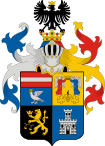Tarcal
Tarcal | |
|---|---|
 Aerial photo of Tarcal | |
|
UTC+2 (CEST) | |
| Postal code | 3915 |
| Area code | +36 47 |
| Website | http://tarcal.hu/ |
Tarcal is a village on the eastern edge of
Geography
Tarcal is located at 48°07′N 21°25′E / 48.117°N 21.417°E, at the western foot of the 516 m high Nagy Hill at Tokaj at the southernmost foothills of the Eperjes-Tokaj mountain range..
Tarcal is probably the best grape-growing locale of the world famous Tokaj-Hegyalja wine district. All the traditional Tokaji grape varieties (
History
The estate was presented to Captain Turzul by Árpád at the time of the Conquest.
In 1941 the population of Tarcal was 4004.
During deportations to the
In 2015 an 8.5-meter statue of Jezus was displayed on a hill above the village.[3] The sculptor was Sándor Szabó.[4]
Jewish community
The Jewish population in Tarcal was 299 in 1941. Most of the Tarcal Jews were murdered in the
Among the famous rabbis of Tarcal were:
- Rabbi KalivRebbe.
- Rabbi Yechezkel Paneth (1813–1822), author of Mare Yeheskel (Marmaros, 1875).
- Rabbi dayanand teacher in Tarcal.
- Rabbi Yaakov Shapira (1876–1906), a famous scholar, often mentioned in the halachic responsa of the famous rabbis of Hungary.
- Rabbi Yehoshua Heshil Rosner (1906–1944). He was the son-in-law of Rabbi Yaakov Shapira. Rabbi Rosner was murdered in the Holocaust in 1944.
Sights of Tarcal
The architectural sights of the village are mostly connected to the Rákóczi family. The mansions called King court, Rákóczi tavern and Sebeö mansion got their present form at the end of the 18th century.
The
Another interesting sight of Tarcal may be the Andrássy Manor, which was built in baroque style in the 16th century. Under the mansion, owned by the Andrássy family for several decades, there is a hidden cellar mainly used for producing and storing wine.
Images

Notes
- ^ Tarcal at the Hungarian Central Statistical Office (Hungarian).
- ^ Tarcal at the Hungarian Central Statistical Office (Hungarian). 2012
- ^ http://tarcal.hu/aldo-jezus-szobor/ access 22 July 2015
- ^ https://www.kozterkep.hu/~/25062/Aldo_Krisztus_Tarcal_2015.html access 22 July 2015
- ^ "Pinkas Hakehillot Hungary: Tarcal". Jewishgen.org. Retrieved 1 January 2014.
- ^ https://cja.huji.ac.il/browser.php?mode=alone&id=285419 Date of synagogue. Retrieved 31. October 2020.
References
- [1]
- [2]
- Street map (in Hungarian)


